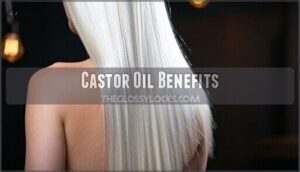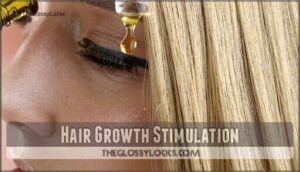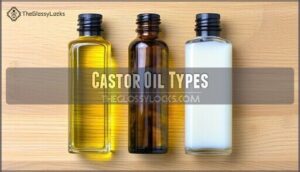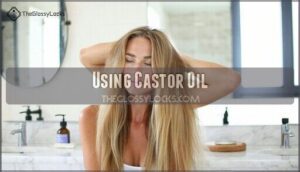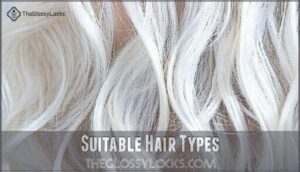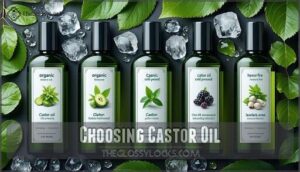This site is supported by our readers. We may earn a commission, at no cost to you, if you purchase through links.
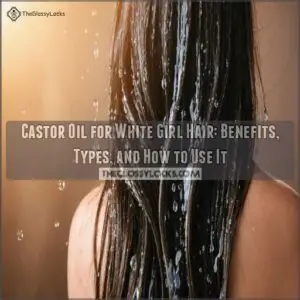 Castor oil can work wonders for white girl hair by locking in moisture, taming frizz, and promoting healthier growth.
Castor oil can work wonders for white girl hair by locking in moisture, taming frizz, and promoting healthier growth.
Its rich, thick texture coats each strand, making it a fantastic choice for reducing breakage and adding shine. Whether your hair is fine, wavy, or straight, castor oil nourishes the scalp and helps create a smoother, more manageable look.
Jamaican Black Castor Oil is especially popular for its extra conditioning power. Just massage a small amount into your scalp or ends, let it sit, and rinse thoroughly.
Want softer, stronger hair? This might just be your new secret weapon to achieve healthier growth, with castor oil being the key, and it helps in reducing breakage.
Table Of Contents
- Key Takeaways
- Castor Oil Benefits
- Hair Growth Stimulation
- Castor Oil Types
- Using Castor Oil
- Hair Care Routine
- Castor Oil Application
- Suitable Hair Types
- Frequency of Use
- Potential Side Effects
- Choosing Castor Oil
- Frequently Asked Questions (FAQs)
- Can you use castor oil on white hair?
- How to use castor oil for Caucasian hair?
- Can white girls use black castor oil?
- Who should not use castor oil for hair?
- How can I tell if my castor oil is pure and not mixed with other oils?
- Can castor oil protect hair from chlorine?
- Does castor oil help with sun-damaged hair?
- How does castor oil affect dyed hair?
- Is castor oil safe for children’s hair?
- Can castor oil be used on extensions?
- Conclusion
Key Takeaways
- You’ll benefit from castor oil’s moisturizing properties that lock in hydration, reduce frizz, and add shine to your hair, making it more manageable with regular use.
- You can choose between pure castor oil or Jamaican Black Castor Oil depending on your needs, with JBCO offering extra conditioning power due to its unique ash content.
- You should apply a small amount to your scalp or ends, massage gently, leave it on for 1-2 hours (or overnight for deep treatment), then wash thoroughly to prevent buildup.
- You’ll want to limit application to once or twice weekly to avoid potential side effects like hair felting, heaviness, greasiness, or in rare cases.
Castor Oil Benefits
Castor oil works wonders by keeping your hair moisturized, improving scalp health, and reducing breakage. It’s like giving your hair a little TLC that’s both simple and effective!
Moisturizing Properties
Castor oil’s humectant action locks in moisture, making it a go-to for dryness prevention in white girl hair.
Castor oil locks in moisture effortlessly, keeping white girl hair hydrated, soft, and beautifully shiny all day long.
It boosts water retention, ensuring scalp hydration and silky strands. Plus, its thick texture enhances shine and keeps hair soft.
- Seals moisture to prevent dryness
- Adds shine for a polished look
- Nourishes hair for lasting softness
- Improves overall hair moisture balance
Scalp Health Improvement
Healthy hair starts with a happy scalp.
A happy scalp is the foundation for strong, vibrant hair—nourish it, and your locks will thrive!
Castor oil benefits include reducing inflammation and balancing pH, which soothes irritation and fights dandruff.
Its thick consistency improves circulation during a massage, boosting follicle nourishment.
By keeping your scalp hydrated and clean, castor oil supports overall hair health, think of it as a spa day for your scalp—relaxing and rejuvenating!
Reduction in Hair Breakage
In the case of hair breakage, castor oil works like a superhero cape for your strands.
Its thick, hydrating benefits lock in moisture, boosting hair elasticity and preventing split ends.
By strengthening the cuticle layer, it adds protection against daily damage.
Whether you’re tackling frizz or repairing damage, castor oil for hair keeps your locks resilient and ready to shine.
Hair Growth Stimulation
If you’re hoping to give your hair growth a boost, castor oil might be worth a try.
While scientific evidence is limited, many people swear by its ability to nourish the scalp and encourage healthier, fuller hair over time.
Scientific Perspective
Ricinoleic acid, the star component of castor oil, may boost scalp circulation, creating a healthier environment for hair follicles.
Its anti-inflammatory and antimicrobial properties support scalp health, while fatty acids and antioxidants nourish and protect.
While there’s no solid scientific proof it triggers hair growth, it strengthens follicles and reduces breakage, indirectly helping your hair thrive with its antioxidants.
Anecdotal Evidence
Many users swear by castor oil for hair growth, sharing personal testimonials about thicker, healthier locks.
While individual results vary, reported successes include:
- Filling in thinning spots on Caucasian hair.
- Encouraging regrowth in sparse areas.
- Boosting overall hair density.
It’s not magic, but incorporating castor oil into your hair care routine might just be the growth boost you need!
Castor Oil Types
In the case of castor oil, you’ve got options that suit different needs and preferences.
From pure castor oil to Jamaican Black Castor Oil, each type offers unique benefits for your hair care routine.
Pure Castor Oil
Pure castor oil is a powerhouse for hair care, thanks to its oil purity and nutrient-rich composition.
Extracted via cold-pressing, it avoids harmful refining processes, ensuring maximum benefits. Watch out for adulteration risks—always check labels!
Ethical sourcing matters too, so choose responsibly. Consistent use improves overall scalp health.
Here’s a quick breakdown:
| Feature | Benefit |
|---|---|
| Oil Purity | Retains nutrients |
| Extraction Methods | Cold-pressed for quality |
| Adulteration Risks | Avoids contamination |
| Refining Process | Preserves properties |
| Ethical Sourcing | Supports fair practices |
Jamaican Black Castor Oil
Jamaican Black Castor Oil stands out due to its Ash Content from roasting differences, a result of traditional methods.
This unique process boosts its effectiveness for scalp detox and dandruff control.
Perfect for castor oil hair care, it nourishes deeply, promoting hair growth and repair.
Whether tackling dryness or damage, this versatile oil is a hair care game-changer!
Using Castor Oil
When you’re ready to use castor oil, start by applying it to your hair and scalp with clean hands or a brush.
Massage it in gently, leave it on for a while, and let the magic happen!
Applying to Hair
Start with a small application amount—about a dime-sized drop of castor oil for hair.
Use your fingers or application tools like a brush for even coverage. Apply to wet or dry hair, focusing on ends for smoother hair appearance.
For a deeper hair oil treatment, use heat application or leave it on overnight. Consider various product options for application.
Perfect for Caucasian hair care routines, and using hair oil can be very beneficial.
Massaging Scalp
After applying castor oil for hair, focus on scalp stimulation with gentle massage techniques.
Use your fingertips in circular motions to boost blood circulation and enhance oil absorption.
This scalp treatment both promotes hair growth and offers relaxation effects, like a mini spa moment at home.
Regular practice may increase blood flow to the scalp.
A few minutes of this can transform your hair care routine!
Leaving It On
When letting castor oil hair treatments work, balance is key.
Try an Overnight Treatment for deep conditioning, but watch for Scalp Sensitivity or Residue Buildup.
The thick oil needs time for proper hair shaft penetration and Oil Absorption.
For Caucasian hair, hair conditioning works best with 2-hour Application Duration, preventing buildup while giving your strands ideal softness and shine.
Hair Care Routine
Keeping castor oil in your hair care routine can make styling easier and your strands healthier. Whether you’re smoothing frizz or prepping for detangling, it works wonders when used correctly.
Smooth Frizzy Ends
Frizz driving you nuts? Castor oil for hair can be your go-to solution!
Its Hydration Sealing locks in moisture, smoothing the cuticle for silky hair.
For Split End Repair, rub a tiny amount on dry ends—it’s magic.
Want Frizz Prevention Tips? Mix Castor Oil Blends with lighter oils for easier application. Say hello to hair smoothness!
Deep Treat
For a deep treat, try an Overnight Treatment with castor oil blends.
Massage it in as a scalp mask or use DIY recipes for intense hair moisturization.
Adding heat application, like a warm towel, boosts absorption.
You can also find pre-mixed castor solutions for easier application.
This hair treatment works wonders for Caucasian hair, leaving it silky and nourished.
Castor oil for hair truly transforms dry strands!
Prep for Detangling
After a deep treat, prepping for detangling is key to hair manageability. Start by sectioning hair for easier handling.
Apply castor oil for hair hydration, focusing on ends. Use gentle tools like a wide-tooth comb to avoid breakage.
A quick scalp massage boosts oil distribution. For Caucasian hair, this method smooths hair texture, making detangling a breeze.
Castor Oil Application
You’ll want to apply castor oil correctly to get the best results without making your hair feel heavy or greasy.
With a little prep and the right technique, you can easily work it into your routine for healthier, shinier hair.
Preparing Your Hair
Before using castor oil for hair, start with pre-treatment cleansing to remove buildup.
Use gentle scalp exfoliation to clear pores, boosting absorption. Detangling methods prevent breakage, especially for Caucasian hair.
Maintain moisture balance by hydrating your hair beforehand—dry strands absorb unevenly. Sectioning hair simplifies application, ensuring even coverage.
Adjust for hair porosity, as it affects how your hair retains hydration during treatment, which is crucial for effective castor oil use.
Applying Castor Oil
Start with a small application amount—just a few drops of castor oil. Warm it between your palms, then massage it into your scalp using gentle, circular motions.
For an overnight mask, dilute it with lighter oils like jojoba to avoid stickiness. Explore different application product options for easier use.
Patch testing is smart, especially for Caucasian hair, to confirm it complements your hair care routine.
Washing It Off
To wash off castor oil, use warm water to loosen it up, then apply a clarifying shampoo to tackle buildup.
Massage gently to avoid hair matting, and rinse thoroughly.
Follow with conditioner to restore moisture. Stick to proper rinsing techniques—no shortcuts! Castor oil for hair works wonders, but skipping this step can leave your locks feeling heavy.
Suitable Hair Types
You might wonder if castor oil works for your hair type, and the good news is, it’s incredibly versatile.
Whether your hair is fine, thick, straight, or wavy, castor oil can provide moisture and strength when used correctly.
Caucasian Hair
Castor oil for hair works wonders on Caucasian hair, especially for fine or color-treated locks.
It boosts hair thickness, strengthens strands, and enhances shine.
Concerned about scalp sensitivity or blonde concerns? Its gentle formula nourishes without weighing down.
Massage it in for hair growth and thickening, leaving your hair healthy and radiant.
Perfect for achieving smooth, manageable hair! Caucasian hair’s fragile cuticle structure means it often requires more moisture, which can be addressed with castor oil for healthy and radiant results.
Mixing With Other Oils
If castor oil feels too heavy on its own, mix it with lighter oils like coconut, argan, or jojoba.
This improves absorption rates and balances scalp sensitivity.
Experiment with oil ratios to find the best combinations for scent and texture.
Blending also boosts natural hair care benefits, promoting hair growth while leaving your hair soft and manageable!
Frequency of Use
Using castor oil too often can leave your hair heavy or greasy, so it’s best to limit applications to once or twice per week.
Pay attention to how your hair feels—if it starts looking dull or sticky, it’s a sign to scale back.
Optimal Application Frequency
Finding the right balance is key for castor oil hair growth. Too much, and you’ll risk buildup or overwhelm sensitive scalps.
A weekly limit of 1-2 times works for most, depending on hair porosity and product absorption.
- Apply sparingly to avoid greasy roots.
- Focus on scalp and ends.
- Adjust for natural hair care needs.
- Monitor scalp sensitivity regularly to maintain a healthy scalp.
Signs of Overuse
Overusing castor oil? Your hair might tell you! Watch for Buildup Symptoms like dullness or greasiness and Product Overload leading to Hair Matting.
Scalp Irritation or hair drying from poor hair washing signals trouble too. Keep it balanced—you’re moisturizing, not drowning your hair.
| Symptom | What It Means |
|---|---|
| Dullness | Excess residue remains |
| Greasiness | Product overload |
| Scalp Irritation | Inflammation, itchiness |
| Hair Matting | Tangled, sticky strands |
| Hair Drying | Blocked moisture enters |
Reorganizing your hair care routine can help prevent these issues, focusing on moisturizing and avoiding excess residue to keep your hair healthy.
Potential Side Effects
Using castor oil might sound like a miracle fix, but it’s not entirely risk-free.
You could face allergic reactions or rare issues like hair felting, so it’s smart to stay cautious.
Allergic Reactions
Before using castor oil, always do a patch test to avoid allergic reactions, especially if you’ve got a sensitive scalp.
Reaction symptoms like itching, redness, or swelling are signals to stop use immediately.
Stick to high oil purity to reduce risks. If unsure, consult a dermatologist first.
Safe castor oil uses start with knowing your scalp’s limits!
Hair Felting
Hair felting caused by castor oil can lead to irreversible damage. It’s rare but leaves hair tangled in a rock-like mass.
Frequent treatments can cause hair to weaken.
To avoid detangling difficulty, follow these preventative measures:
- Mix castor oil with lighter oils, like coconut.
- Limit application to once weekly.
- Avoid direct application on long hair.
If felting occurs, seek professional intervention—hair removal might be the only solution.
Choosing Castor Oil
When picking castor oil, you’ll want to focus on quality options like organic, cold-pressed, or hexane-free types for the best results.
These choices guarantee you’re getting a pure product that’s gentle on your hair and scalp.
Organic Vs Non-Organic
Choosing between organic and non-organic castor oil? Organic options skip pesticides, offering better nutrient density and eco-friendly vibes.
Non-organic might save cash but could include pesticide residue. Certification standards guarantee quality, so check labels.
Think of it like picking apples—organic feels fresher, right? Here’s a quick comparison:
| Feature | Organic Castor Oil | Non-Organic Castor Oil |
|---|---|---|
| Pesticide Residue | None | Possible |
| Nutrient Density | Higher | Moderate |
| Environmental Impact | Eco-friendly | May harm ecosystems |
This comparison highlights the key differences, making it easier to decide between organic and non-organic castor oil based on factors like environmental impact.
Cold-Pressed and Hexane-Free Options
Cold-pressed castor oil is your best bet for purity and effectiveness. It’s extracted without heat, keeping nutrients intact.
Hexane-free options avoid harmful chemicals, making them safer for your scalp.
- Cold-pressed benefits: Retains nutrients for healthier hair.
- Hexane dangers: Prevents chemical exposure.
- Purity standards: Guarantees a natural hair product.
- Hair growth tips: Supports your castor oil treatment journey.
Frequently Asked Questions (FAQs)
Can you use castor oil on white hair?
Funny how castor oil works wonders on all hair types, including white hair.
Its rich fatty acids moisturize, strengthen, and boost shine.
Just don’t overdo it—too much can weigh your hair down or cause buildup, which is why balance is key to using castor oil effectively.
How to use castor oil for Caucasian hair?
Massage a small amount of castor oil into your scalp and ends, avoiding the hair shaft if it’s fine.
Leave it on for 1-2 hours, then rinse thoroughly with shampoo to prevent buildup.
Can white girls use black castor oil?
Black castor oil works wonders for all hair types, including yours.
It deeply nourishes, strengthens, and promotes growth.
Just start with small amounts to avoid buildup, and you’ll love the results!
Who should not use castor oil for hair?
If you’ve got a sensitive scalp, allergies, or conditions like dermatitis, skip castor oil—it can irritate.
Also, avoid it if your hair tangles easily, as its thickness might cause matting or buildup.
How can I tell if my castor oil is pure and not mixed with other oils?
Check the label for "100% pure" and certifications like USDA Organic.
Pure castor oil is thick, with a mild scent.
If it’s too runny or smells odd, it’s likely mixed with other oils.
Can castor oil protect hair from chlorine?
Think of castor oil as your hair’s lifeguard—it forms a barrier that locks in moisture, reducing chlorine damage.
Apply a thin layer before swimming, and wash thoroughly afterward to keep hair healthy.
Does castor oil help with sun-damaged hair?
Castor oil nourishes sun-damaged hair by restoring moisture, soothing dryness, and protecting strands from further harm.
Its fatty acids and antioxidants hydrate deeply, making your hair feel softer, shinier, and more manageable after sun exposure, with antioxidants playing a crucial role.
How does castor oil affect dyed hair?
Dyed hair loves moisture, and castor oil delivers!
It hydrates, reduces breakage, and helps repair damage from coloring.
Just don’t overdo it—too much can weigh hair down or cause buildup.
Balance is key!
Is castor oil safe for children’s hair?
Treat castor oil like a superhero cape for your kid’s hair—safe, but with limits.
It’s hydrating and protective, but always do a patch test first, and avoid overuse to prevent buildup or irritation.
Can castor oil be used on extensions?
You can apply castor oil sparingly to your extensions for added shine and moisture.
It’ll help maintain them longer, but don’t overdo it—a few drops is all you need to prevent buildup or weighing them down.
Conclusion
Verily, castor oil for white girl hair isn’t just a passing trend—it’s a game-changer for your locks.
You’ll notice healthier strands with consistent use, whether you choose pure or Jamaican Black varieties.
Remember to start with small amounts, adjust frequency based on your hair’s response, and be patient, as your journey to stronger, shinier hair is worth the effort.
Isn’t it time you gave your tresses the royal treatment they deserve?

